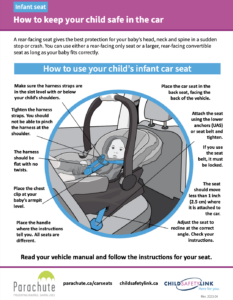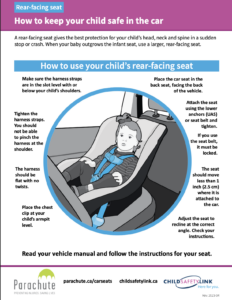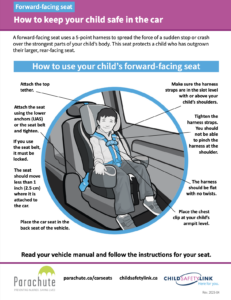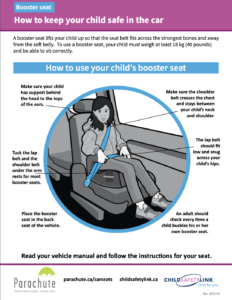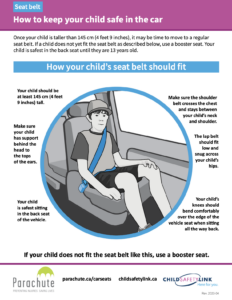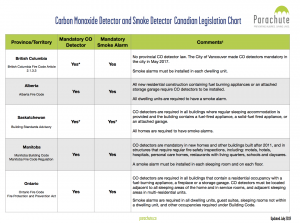There are three factors to choosing the right car seat for your child.
- It fits your child’s weight, height, age and development. Choose the car seat or booster seat that fits your child’s weight, height, age and development. You can find this information on the labels on the seat as well as in the instruction manual.
- The seat can be correctly installed and used in your vehicle. Not all car seats and booster seats fit safely in all vehicles. Ensure the seat can be correctly installed in your vehicle.
- The seat fits your budget. All car seats approved for use in Canada will have the National Safety Mark (NSM), and meet Canada’s high safety standards – no matter the price tag. A seat that does not have the National Safety Mark is not legal for sale or use in Canada.
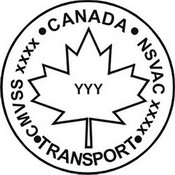
NOTE: All car seats must be tested to meet government safety standards in order to be sold in Canada. Buying a car seat in Canada will ensure that it meets Canadian safety standards set by Transport Canada. Look for the National Safety Mark: it is proof that the car seat meets Canadian safety standards.
Don’t rush through the stages. Keep children in each stage for longer and in a seat that fits them.
Rear-facing seat
- A rear-facing car seat provides the best protection for your child’s head, neck and spine in a sudden stop or crash.
- All infants must use a rear-facing seat.
- Use a rear-facing-only car seat or a larger, rear-facing convertible seat; either is safe as long as your child fits correctly.
- Your child is safest riding rear facing until 2, 3 or even 4 years old.
- Keep your child rear facing for as long as they still fit the larger, rear-facing seat.
Forward-facing seat
- A forward-facing seat uses a five-point harness to spread the force of a sudden stop or crash over the strongest parts of your child’s body.
- Start using a forward-facing seat with a five-point harness when your child has outgrown their larger, rear-facing seat. This usually happens between ages 2 to 4.
- Keep your child in a forward-facing seat with a five-point harness until your child weighs at least 18 kg (40 lbs) and is able to sit correctly in a booster seat. This may be at 4, 5, 6 or even 7 years old.
- If the child outgrows their forward-facing seat before they are ready to move to a booster seat, you will need a seat with a 5-point harness that will hold a taller, heavier child.
Booster seat
- A booster seat positions your child so that the adult seat belt fits safely across their strongest bones and away from their soft belly.
- Your child must weigh at least 18 kg (40 pounds) to use a booster seat.
- A booster seat always requires both a lap and a shoulder seat belt.
- Your child must also be able to sit straight and tall for the whole ride, without moving around or unbuckling. This usually happens between ages 4 and 7.
- Keep using a booster seat until your child is at least 145 cm (4 feet 9 inches) tall and fits the adult seat belt correctly.
- Buckle a booster seat when not in use; otherwise, the seat may hit passengers or the driver if there is a sudden stop or crash.
- It is important to use a booster seat even in provinces/territories that do not yet have laws mandating their use.
Seatbelt alone
- The adult seat belt must fit properly over the child’s strongest bones to protect a child.
- Once a child is taller than 145 cm (4 feet 9 inches), they may begin to safely fit the adult seat belt. This usually happens between age 10 to 12.
Use the five-step test to see if your child can safely move from a booster seat to a seat belt:
- Can your child sit all the way back against the vehicle seat?
- Do your child’s knees bend comfortably over the edge of the vehicle seat without slouching?
- Does the lap belt stay low and snug across their hip bones?
- Does the shoulder belt cross your child’s chest and stay between their neck and shoulder?
- Can your child sit like this for the entire ride without slouching?
Until your child can meet all five steps, keep using a booster seat.
If neither the seat belt alone nor the current booster seat position the lap and shoulder belt properly, a different model of booster seat is required until your child grows a little taller.
A child may pass all five steps (above) to use a seat belt in one car but still need to use a booster seat in another vehicle.
The back seat is the safest place for children. Children should not sit in the front seat until they are at least 13 years old.
If you need more help, where can you find it?
Child Passenger Safety Technicians receive standardized, professional training through the Child Passenger Safety Association of Canada. Find a technician near you: https://www.cpsac.org/find-a-tech/
Contact the manufacturer of the car seat or booster seat for customer support, including video chat installation help. https://www.cpsac.org/caregiver-resources/

